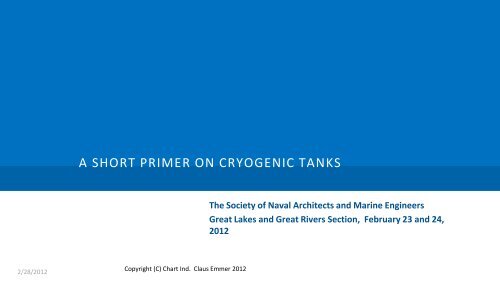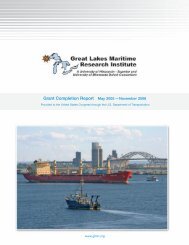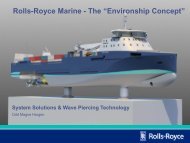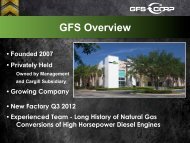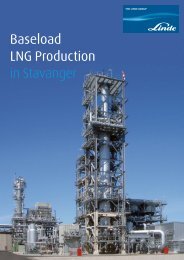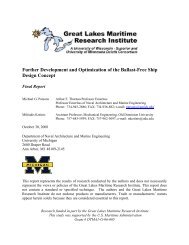A SHORT PRIMER ON CRYOGENIC TANKS - Amazon Web Services
A SHORT PRIMER ON CRYOGENIC TANKS - Amazon Web Services
A SHORT PRIMER ON CRYOGENIC TANKS - Amazon Web Services
You also want an ePaper? Increase the reach of your titles
YUMPU automatically turns print PDFs into web optimized ePapers that Google loves.
A <strong>SHORT</strong> <strong>PRIMER</strong> <strong>ON</strong> <strong>CRYOGENIC</strong> <strong>TANKS</strong><br />
The Society of Naval Architects and Marine Engineers<br />
Great Lakes and Great Rivers Section, February 23 and 24,<br />
2012<br />
2/28/2012<br />
Copyright (C) Chart Ind. Claus Emmer 2012
Chart started to build<br />
LNG systems in the<br />
early 1990’s.<br />
Bio-Medical Facility<br />
Marietta GA<br />
Bulk & Engineered Storage Facility<br />
New Prague, Minnesota<br />
Heat Exchanger Facility<br />
Tulsa, OK<br />
Energy and Chemicals Facility<br />
Houston, Texas<br />
Energy and Chemicals<br />
The Woodlands, TX<br />
Heat Exchanger Facility<br />
Lacrosse, Wisconsin<br />
Chart Headquarters<br />
Cleveland, Ohio<br />
Energy and Chemicals Facility<br />
New Iberia, Louisiana<br />
Packaged Gas Facility<br />
Canton, Georgia<br />
Service and Repairs Facility<br />
Holly Springs, Georgia<br />
A bit about us….<br />
Chart Europe GmbH<br />
Solingen, Germany<br />
Ferox a.s.<br />
Decin, Czech Republic<br />
2/28/2012<br />
Chart Cryogenic Equipment<br />
Changzhou, China<br />
Chart Hailu Cryogenic Equipment<br />
Zhangjiagang, China<br />
WHO WE ARE…<br />
LNG Work<br />
Sites in Green<br />
Copyright (C) Chart Ind. Claus Emmer 2012<br />
• We designs LNG tanks on three continents<br />
• We design and build liquefiers in the US<br />
• We design and build ship LNG tanks on two<br />
continents.<br />
2
2/28/2012<br />
16 largest ships emit as much as all 800<br />
million cars in the world. One ship can emit<br />
5000 tons of sulfur per year<br />
(source: The Guardian)<br />
WHY NATURAL GAS?<br />
Copyright (C) Claus Emmer 2011<br />
3
2/28/2012<br />
Why LNG?<br />
• The main reason to liquefy a gas is for ease of storage and<br />
transportation.<br />
• It lowers storage costs, since cryogenic storage is at low<br />
pressures.<br />
• It is easier to pump a liquid than to compress a gas.<br />
• A 15 HP cryogenic pump replaces a 175 HP<br />
compressor.<br />
Why Industry has switched to cryogenic storage…<br />
Volume reduction makes it easier to transport<br />
And energy density applies to vehicle fuels…<br />
FIRST, A BIT ABOUT LNG<br />
Copyright (C) Chart Ind. Claus Emmer 2012<br />
But of course, if you compare<br />
to Type IV cylinders, they’ll<br />
take up only 3 to 4 times the<br />
space, and cost maybe 40%<br />
more.<br />
Of course, this is a nasty<br />
example, since it<br />
compares to steel<br />
cylinders at lower<br />
pressures.<br />
4
Remember all fuels burn – or they wouldn’t be a fuel…<br />
Some fuel<br />
densities<br />
2/28/2012<br />
PROPERTIES OF LNG<br />
Some basic notions<br />
• LNG is primarily liquefied methane, with some ethane and<br />
. propane.<br />
• Is has no moisture, oil, or odor.<br />
• It is stored at a temperature of around -259 °F and<br />
pressures less than 250 PSIG.<br />
• At room temperature it is lighter than air, and quickly<br />
dissipates.<br />
• Primary hazards are:<br />
• It’s very cold!<br />
• It can displace oxygen and act as an asphyxiant<br />
Copyright (C) Chart Ind. Claus Emmer 2012<br />
http://www.fe.doe.gov/programs/oilgas/publications/lng/LNG_primerupd.pdf<br />
5
The “Flat Bottomed” tank<br />
• Stores very large volumes at no pressure. Generally<br />
cheapest at volumes above 3 billion gallons.<br />
• The Mobile Tanker Designed for Road or Rail<br />
• Road tankers, ISO containers, Rail cars.<br />
2/28/2012<br />
TANK TYPES<br />
• The Shop built Storage Tank.<br />
• Vertical or horizontal pressure vessels.<br />
• Volumes larger than 250,000 gallons are costly or<br />
impossible to transport.<br />
• Specialized tanks<br />
• Ship tanks, Vehicle tanks<br />
Copyright (C) Chart Ind. Claus Emmer 2012<br />
6
2/28/2012<br />
• Inside it is -256 °F, outside it is room temperature<br />
or higher. A difference of more than 300<br />
degrees.<br />
• Heat will transfer:<br />
1. By mechanical conduction – the bracing<br />
between the inner and the outer tank,<br />
and the piping between them.<br />
2. By Convection – i.e. the gas remaining in<br />
the Annular space. We reduce that by<br />
pulling a vacuum.<br />
3. By radiation – by using shine surfaces to<br />
reflect the radiation.<br />
• So in tank design we make the mechanical<br />
components as thin as possible – just strong<br />
enough for the required conditions.<br />
• We pull a vey high vacuum – less than 1 millionth<br />
of an atmosphere.<br />
• We minimize radiating by applying multiple layers<br />
of reflective materials.<br />
This is a generic tank.<br />
It is the same if it is<br />
horizontal or vertical<br />
KEY PARTS OF A <strong>CRYOGENIC</strong> TANK.<br />
Copyright (C) Chart Ind. Claus Emmer 2012<br />
7
• Most often used on mobile equipment<br />
The cone support is probably<br />
the strongest, but has the<br />
highest heat leak.<br />
• Used on mobile equipment and stationary tanks<br />
• Most often used on stationary tanks<br />
Straps between the inner and<br />
outer are a common support<br />
system.<br />
Used on mobile equipment and stationary tanks<br />
2/28/2012<br />
COMM<strong>ON</strong> SUPPORT SYSTEMS<br />
A trunnion support is very<br />
effective, but is a real design and<br />
manufacturing challenge on<br />
mobile equipment<br />
Insulating bottom supports very<br />
effective, but hard to design for<br />
mobile equipment.<br />
Copyright (C) Chart Ind. Claus Emmer 2012<br />
8
2/28/2012<br />
• To the right are the classic curves showing<br />
the effect of various types of insulation at<br />
various levels of vacuum on heat leak.<br />
• The all follow a similar pattern…<br />
• At atmospheric pressure they are all<br />
poor insulators, though Aerogel is about<br />
twice as effective as perlite and SI.<br />
• As vacuum increases, they become<br />
rapidly more effective, with SI being<br />
most effective by a factor of 100 at the<br />
low ranges.<br />
• Very low vacuum levels are achieved in a<br />
“cold” vacuum, when absorbents and getters<br />
in the vacuum space are most effective.<br />
• Less effective insulation needs to be thicker to<br />
get the same insulating effect.<br />
Copyright (C) Chart Ind. Claus Emmer 2012<br />
About here is<br />
where SI tanks<br />
work<br />
About here is<br />
where perlite<br />
tanks work<br />
Aerogel Beads as Cryogenic Thermal Insulation System<br />
NASA Tech report, Fesmire & Augustynowicz<br />
VACUUM<br />
9
Common insulations<br />
Insulation<br />
R value<br />
Fiberglass without vacuum 6.4<br />
Foam without vacuum 8.3<br />
Powder without vacuum 6.2<br />
Vacuum 25<br />
Evacuated Perlite 60<br />
Superinsulation 170<br />
• Superinsulation<br />
Lots of manufacturing<br />
Technology needed<br />
To do it right<br />
2/28/2012<br />
INSULATI<strong>ON</strong><br />
Cryogenic Insulations for the Distribution of Liquefied<br />
Gases. H. M. Lutgen, IOMA 1053<br />
• Perlite<br />
• Some common insulations:<br />
• Foam<br />
This is the same stuff – but<br />
cleaner and dryer – that<br />
you use in your garden.<br />
Foam insulation is<br />
generally prefabricated<br />
Copyright (C) Chart Ind. Claus Emmer 2012<br />
10
• All Tanks NEED…<br />
1. A liquid container of materials appropriate for<br />
low temperature.<br />
2. Insulation to keep the liquid at that low<br />
temperature.<br />
3. Safety devices to make sure that pressure’s<br />
don’t get higher than the container can handle.<br />
4. A method to get the liquid into the tank<br />
5. A means to get the liquid out of the tank.<br />
6. A method to get excess gas out of the tank.<br />
7. Instrumentation to find out what’s happening.<br />
8. An outer container to keep the insulation in<br />
place…<br />
• Tank Design NEEDS<br />
1. Designed to the proper Codes and regulations<br />
2. To be strong enough to hold the liquid at some<br />
defined pressure.<br />
3. Supports be strong enough to be transported<br />
from the factory to the destination.<br />
4. In addition to be strong enough for any service<br />
conditions.<br />
1. Seismic, wind force, road forces, wave<br />
forces, vibration, heat, corrosion.<br />
5. Thermally efficient design to keep the liquid cold<br />
as long as possible.<br />
6. Proper safety features for normal operation.<br />
7. Design for maintainability.<br />
2/28/2012<br />
8. Application requirements, such as pump, high<br />
TANK DESIGN<br />
flow , etc. (<br />
We once built a 15,000<br />
gallon hydrogen tank<br />
designed to be emptied in<br />
five minutes or less.)<br />
Copyright (C) Chart Ind. Claus Emmer 2012<br />
11
2/28/2012<br />
Some of the Basics<br />
• Fill lines<br />
• Top and bottom fill lines if pressure needs to be<br />
constant during fill.<br />
• Top filling lowers pressure<br />
• Bottom filling raises pressure.<br />
• Vent lines<br />
• Relief system<br />
• Vent system<br />
• Pressure Control System<br />
• Regulators and vaporizers<br />
• Instrumentation<br />
• Product Withdrawal<br />
• As gas<br />
Typical Piping Schematic<br />
C-1<br />
C-2<br />
*<br />
V-35<br />
E-1<br />
*<br />
V-20<br />
V-25<br />
*<br />
V-37<br />
*<br />
V-43<br />
*V-22<br />
*<br />
V-7<br />
V-31<br />
*V-6<br />
*V-12<br />
V-4<br />
*V-1<br />
V-45<br />
P-1<br />
P-4<br />
V-17<br />
V-23<br />
V-29<br />
*<br />
VACUUM<br />
V-27<br />
J<br />
V-34<br />
*<br />
I<br />
D<br />
V-9<br />
A<br />
B<br />
V-44<br />
C<br />
E-2<br />
E-3<br />
G<br />
*<br />
E<br />
F<br />
V-38<br />
V-8<br />
S2<br />
90%<br />
V-10<br />
*<br />
*<br />
V-39<br />
V-33<br />
M<br />
N<br />
*<br />
*<br />
DN80<br />
V-2 V-36<br />
V-18<br />
V-30 C4A<br />
V-40<br />
V-26<br />
P101<br />
V-15<br />
PT11<br />
V-32<br />
V-16<br />
LI20<br />
LT21<br />
V-13<br />
V-5<br />
V-41<br />
V-28 C3A<br />
V-24<br />
V-19<br />
DN50<br />
TANK C<strong>ON</strong>STRUCTI<strong>ON</strong><br />
• As Liquid<br />
• Gas safe vent system<br />
• Possible re-cooling system.<br />
C-5<br />
V-14<br />
V-42<br />
*V-11<br />
V-3<br />
V-21<br />
Copyright (C) Chart Ind. Claus Emmer 2012<br />
12
NER – the Boil Off Rate<br />
• Thermal performance is usually stated in % per day of<br />
evaporated product at atmospheric pressure.<br />
• Typical NER’s on larger vacuum insulated tanks is on the<br />
order of 0.15 to 0.07 % of capacity per day.<br />
• Thus a normal 15,000 gallon LNG tank will evaporate<br />
about 15 gallons of LNG per day due to thermal<br />
inefficiencies.<br />
• Larger tanks will have lower heat leak as the volume<br />
increases faster than the surface area.<br />
Holding Time<br />
• A moving tank has a better non-venting holding time than<br />
a stationary tank.<br />
• If the tank is not moving, the liquid will stratify – cold<br />
liquid will sink and warm liquid will rise. The pressure in a<br />
stratified tank is set by the warmest liquid on the top.<br />
• Typically, a larger cryogenic tank will rise in<br />
pressure around 3 to 5 PSI per day.<br />
• A road tanker, that is moving and has liquid mixing, rises<br />
at around 1.5 PSI per day. They can have a OWTT of over<br />
1,000 hours.<br />
2/28/2012<br />
Filling tanks<br />
• Consider that the field erected tanks commonly<br />
used in LNG storage are not pressure vessels, and<br />
any vapor formed needs to be handled and<br />
controlled.<br />
• Shop built tanks – are pressure vessels – and are<br />
filled with a single hose from the top with cold<br />
liquid.<br />
• This cold liquid recondenses any vapor in the<br />
vapor space and the pressure in the tank drops<br />
correspondingly.<br />
• There is no practical limit to the top-fill rate,<br />
other than that it must become slower as the<br />
tank becomes fuller, in order not to overfill.<br />
• Since the tanks are pressure vessels, no vapor<br />
needs to be handled – at worst, the liquid is<br />
stored at a slightly higher pressure/temperature.<br />
• Large horizontal tanks – like the 250,000 gallon<br />
units we build – have a long spray bar to<br />
distribute cold liquid evenly along the length<br />
during filling.<br />
OTHER QUESTI<strong>ON</strong>S ABOUT <strong>TANKS</strong>…<br />
Copyright (C) Chart Ind. Claus Emmer 2012<br />
13
2/28/2012<br />
TANK C<strong>ON</strong>STRUCTI<strong>ON</strong> (2)<br />
Copyright (C) Chart Ind. Claus Emmer 2012<br />
14
• Some Key thoughts…<br />
• Lines that are connected to the liquid side of the<br />
tank need to have vapor locks to prevent<br />
excessive heat transfer into the liquid.<br />
• Pressurizing systems need to be sized for<br />
maximum withdrawal rates. And liquid flows into<br />
pressure building circuits by gravity only, so line<br />
sizing and routing is a challenge.<br />
• Liquid to pump essentially flows by gravity. Traps<br />
in pump feed lines limit this flow.<br />
• There is a lot of heat generated by pumps.<br />
Oversizing a pump is counterproductive.<br />
• Stainless steel contracts about 1/32nds of an inch<br />
per foot when it cools. Improper design can rip<br />
things apart.<br />
• Liquid trapped between two valves can generate<br />
much higher pressure than the burst pressure of<br />
a pipe. Proper cryogenic design always includes a<br />
thermal relief device between two lquid valves.<br />
• Moving or sloshing will homogenize the liquid and<br />
remove any false pressure, stratification, or subcool.<br />
2/28/2012<br />
In Practice<br />
• We’re designing and building the entire<br />
fuel system for the first high speed turbine<br />
driven ferry.<br />
http://www.incat.com.au/069VesselBrochure/index.html<br />
TANK DESIGN<br />
Copyright (C) Chart Ind. Claus Emmer 2012<br />
15
2/28/2012<br />
• Key Points<br />
• LNG Has no odor.<br />
• Warm natural gas always rises.<br />
• Need to ensure that no unwanted gas in unexpected<br />
areas, since there is no odor, nor is odor a reliable means<br />
of detection.<br />
• Need to protect non-cryogenic steel piping in contact with<br />
LNG.<br />
• Mitigation….<br />
• Need to have gas detection.<br />
• Need to have means to dilute natural gas concentrations<br />
• Need to have protection in case of fire – inside or outside.<br />
• All stainless construction acts as containment, and is<br />
impervious to spills or cold cracking.<br />
• All key connections fail closed.<br />
• Piping is either vacuum insulated, or purged double<br />
walled piping.<br />
C<strong>ON</strong>STRUCTI<strong>ON</strong> DETAILS<br />
Copyright (C) Chart Ind. Claus Emmer 2012<br />
16
2/28/2012<br />
Component selection is<br />
limited. Not that many<br />
companies manufacture<br />
DNV certified valves, for<br />
example.<br />
And the ones that do<br />
charge accordingly.<br />
C<strong>ON</strong>STRUCTI<strong>ON</strong><br />
The piping is enclosed in a fire<br />
proof (or at least resistant,<br />
purged control room<br />
The safety record of double walled<br />
cryogenic tanks has been exceptional.<br />
And LNG is just another cryogenic liquid.<br />
Some say it is safer than Liquid Oxygen.<br />
Copyright (C) Chart Ind. Claus Emmer 2012<br />
17
2/28/2012<br />
• Typically, ASME pressure vessels that are in a vacuum – i.e. a non-corrosive environment -<br />
are used a minimum of 30 years. We sometimes refurbish piping of tanks built in the 60’s<br />
• In order of priority, vacuum or performance is affected because:<br />
1. The vacuum gauge is removed or exchanged improperly causing a slow vacuum leak.<br />
2. Insulation has settled. This happens with perlite, not with SI.<br />
3. An outer leak on the jacket, due to thermal cycling or contact with cryogen.<br />
4. A leak on the annular piping, due to thermal cycling.<br />
5. A inner tank leak.<br />
• Leaks are very easy to find on super insulated tank.<br />
• And all leaks are easy to fix once they are found.<br />
BREAKING <strong>TANKS</strong><br />
Copyright (C) Chart Ind. Claus Emmer 2012<br />
18
Non-Jacketed Tanks<br />
• There is no effect, since there is no vacuum<br />
to loose.<br />
• But there is a lot of insulation between<br />
inner and outer tank.<br />
Vacuum jacketed Tanks<br />
• Rapid loss of efficiency as annular space<br />
pressures approach 1 atm.<br />
• Heat leak is in proportion to insulation<br />
thickness.<br />
• Since vacuum insulation (perlite or SI) is so<br />
effective, only a small distance of insulation is<br />
needed.<br />
• When vacuum is lost the insulation reverts<br />
back to that of a thin non-jacketed tank.<br />
• To restore vacuum<br />
Restoring vacuum on a jacketed tank is easy.<br />
1. Use Helium to determine location of leak if it is too small<br />
to be seen or heard.<br />
1. Fast with SI Tanks<br />
2. A bit more laborious and slower with perlite.<br />
2. Fix leak<br />
3. Replace getters<br />
4. Reactivate absorbents with heat and vacuum.<br />
• Equipment<br />
• Good for finding leaks down to 10-8 cc<br />
of helium/sec.<br />
• That number is almost meaninglessly<br />
small. Moisture can temporarily plug<br />
that hole.<br />
• And a small pump, up close, has faster<br />
pumping speeds than a big one far<br />
away.<br />
• Getting molecules out at high vacuum<br />
is like having a drunk find a small door<br />
in the dark…<br />
2/28/2012<br />
EFFECT OF VACUUM LOSS<br />
Copyright (C) Chart Ind. Claus Emmer 2012<br />
19
2/28/2012<br />
And you didn’t<br />
believe me about<br />
small pumps….<br />
REAL VACUUMS<br />
Copyright (C) Chart Ind. Claus Emmer 2012<br />
20


